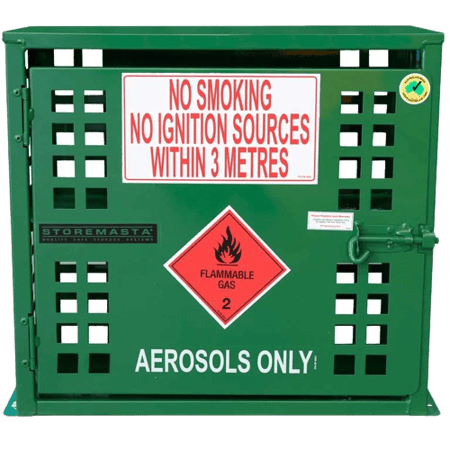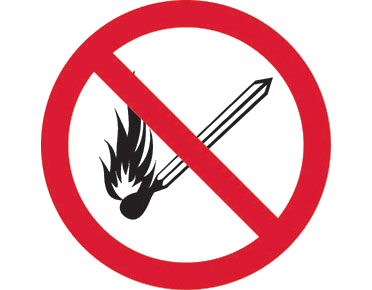A huge range of substances are housed in aerosol cans. Due to their compact size and convenient dispensers, aerosols are used in countless commercial and industrial applications. Aerosol cans are found in nearly every workplace and contain everyday products such as lubricants, insect repellent, paints, cooking oil, deodorisers, whipped cream, solvents, cleaning agents, and personal care products.
However, these little cans pack a lot of potential energy — and can transform into dangerous projectiles or flamethrowers when they rupture or get too hot. In this post, we’ll be highlighting 5 workplace accidents involving aerosols, so you can better understand how to handle and store these items according to the Australian Safety Standards.
IMPORTANT: Aerosol cans are categorised as Class 2.1 Flammable Gases and should be stored in a dedicated aerosol cage that is properly ventilated and has projectile protection.
1. Aerosol can explosion causes permanent facial injuries to warehouse employee
A worker was stacking cartons of aerosols full of whipped cream onto a pallet — the cartons were sealed. While the worker was moving the boxes, one of the aerosol cans ruptured and burst through the cardboard carton. The worker was struck in the face by the can which fractured his cheekbone and other bones around his left eye. He also suffered a damaged tear duct; detached retina and was left with multiple lacerations to his eyelid.
We introduced this particular workplace incident first, because often workers underestimate the dangers associated with seemingly benign products like whipped cream. This incident really demonstrates the force and potential energy contained in an aerosol can (even one carrying a popular dessert) — and how necessary it is for staff to understand the potential hazards associated with the equipment or products they use, handle and store.
Aerosol cans are safe as long as the dispensing device remains intact. But a puncture, excessive heat, corrosion or a faulty valve can cause an aerosol can to rapidly dispense or explode.
This dangerous situation can create:
- Fire
- Explosion
- Exposure to toxic substances
- Projectile capable of impact damage
Each job task that involves the movement, handling or storage of Dangerous Goods, such as aerosols, should be analysed carefully and included in the worksite’s risk assessment.

Engineering controls can prevent incidents involving aerosol cans in the workplace.
Administrative control measures such as staff training and safe job design should be implemented while engineering controls (such as aerosol cages) should also be considered.
TIP: Download our free eBook Gas Cylinder Storage: compliance and safety requirements to learn more about how to identify, assess and control the risks associated with gas cylinders and aerosol cans at your workplace.
2. Can of cooking oil explodes and burns two kitchen workers
Two cooks were working in a commercial kitchen and an aerosol can of cooking oil had been left on the cooled hotplate (griddle) of the stove. When the stove was turned on the aerosol can heated and exploded causing a fire. Both cooks were injured and burned by the explosion and subsequent oil fire. The staff members were rushed to hospital for burn treatments, therapy and required surgeries.
This incident is an example of poor work practices and inadequate supervision. Like all Class 2.1 Flammable Gases, aerosol cans must be kept away from sources of heat.
Aerosol can explosion injuries can cause immense damage to staff, as well as customers, the surrounding workplace and even the local environment. The risk aerosol explosions pose to staff can range from burns that require a hospital visit — to serious physical injuries and even fatalities.
All staff should undergo training when working with any type of dangerous goods – including common workplace aerosols. Staff also need to be properly monitored at their workstations, to ensure they understand their individual WHS responsibilities — and are correctly following safety procedures. This dedicated training and supervision may not only prevent a hospital visit – but potentially loss of life for staff members and customers who are at the site.
REMEMBER: Your material safety data sheets will explain in detail the precautions for the handling and storage of your aerosol. It’s essential that they are kept away from any heat source, so incidents such as aerosol can fire accidents are prevented in the workplace.
3. Can of marking paint explodes and burns asphalt worker
A paving machine operator was finishing an asphalt driveway. A can of spray paint used for marking the driveway had been left on the screed of the paving machine (which gets very hot). After about 30 minutes of operations the aerosol can of paint overheated and exploded, igniting the clothing of the machine operator. He suffered 2nd and 3rd degree burns to his legs and calves.

A heat source or extreme conditions can create fatal explosions when aerosols are involved.
Again this accident clearly demonstrates why aerosol cans (no matter what substance is stored inside) are classified as Class 2.1 Flammable Gases and must be kept well away from ignition sources and heat. It is important to work with your staff so you can agree upon safe working procedures that are both practical and effective.
IMPORTANT: Australian Standards, including AS 4332 - The storage and handling of gases in cylinders, require that staff must be retrained whenever they have demonstrated substandard performance in safety procedures.
4. Paint can ruptures and sprays mining employee with burning paint
A worker at a mining site was using an acetylene and oxygen torch to cut a mounting hole. He had used an aerosol paint can to mark the location of the hole and lay the spray can at his feet while he used the cutting torch. During the cutting process a piece of molten metal fell onto the aerosol can which ruptured then ignited the paint inside. The worker was sprayed with the burning paint and he received 2nd degree burns to his arms and hands, neck and shoulders, as well as his face.
While this accident again demonstrates the dangers surrounding the aerosol can itself, the incident could have been a whole lot worse if the O2 and Acetylene had ignited and exploded.

Aerosol cans have the ability to rupture, which can cause immense damage to staff who are close to the area.
The safety data sheets of all hazardous substances and dangerous goods should be consulted before designing job tasks. Aerosol paint cans are usually extremely flammable and are nearly always incompatible with oxidisers and highly reactive gases.
TIP: Rupturing cans can create serious accidents in the workplace, such as the above example. Never mishandle or store aerosols without compliant practices, as this may damage the can and lead to harm. If you need to dispose of aerosols, consult with your local waste authority or utilise an approved aerosol can puncture tool.
5. Can of spray adhesive ignites and burns creative designer
A creative designer was dry printing onto a bag and had an aerosol can of adhesive on a table near where she was working. She was working with a heat gun and did not turn it off when she placed it on a stool next to a table. The heat gun was inadvertently pointed toward the spray can which exploded about 10 seconds after the heat gun was set down. Flames rose a metre in height and ignited some other materials on the table — at the same time burning the designer. She subsequently spent 10 days in the hospital burns centre while she received treatment for her arms and face.
This is another example of an employee not understanding what can happen when aerosol cans get hot. There have been many recorded incidents of aerosol fires and explosions simply because the cans overheat.

All staff must be trained to keep the cans away from heat sources and ignition sources.
Whether it’s at the worksite, in the home or in a vehicle, these items must never be exposed to extreme heat or sources of ignition.
TIP: Create aerosol safety awareness by holding regular tool-box talks and workplace safety forums.
Handling and Storing Aerosol Cans
If there’s one key point to take away from this post, make sure your staff don’t underestimate the dangers of aerosol cans! Train all workers to know how to handle and store cans safely, using recommendations from the material safety data sheet, as well as the Australian Standard. To avoid fires and explosions, keep them stored away from ignition sources and heat in a dedicated aerosol cage. To find out more about eliminating the dangerous of aerosol cans, you can quickly and easily download a copy of our FREE eBook.

Living life by the 4 C’s of marketing – communication, coffee, compliance… and more coffee – Leisa Andersen is Storemasta’s Content Marketing Manager. When she’s not writing, you’ll find her enjoying all the good things in life, including shopping, travel and gluten free donuts.
